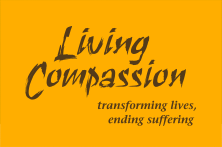The statement that most resonated with me to explore is: “There can be no liberation until a human being recognizes what ego (the illusion of a self that is separate from life) is, and that “it” is not “me” and “I” am not “it.” In this statement is perhaps a clue to the question “In what way is ego an illusion?”
I always feel a tremble of resistance when I encounter the statement “the illusion of a self separate from life is not who I am.” What does that mean? How can this self not be me? The premise flies in the face of what feels true. What feels true is the form that eats and sleeps and experiences and dreams and acts and thinks. This identity, the sum total of a life lived and living, is as real and true as the pain it feels when “I” pinch myself. How can that be an illusion? And how exactly is that separate from life, if everything is the intelligence that animates all?
“Our life is shaped by the mind, we become what we think” is the opening line of the Dhammapada.
What this suggests to me is that identity, “I/me,” is a mental construct, that ego identity is a by-product of a mind process. The mind organizes the sensations, feelings, experiences, and thoughts affiliated to this form and categorizes/abstracts the whole as a “someone.” The “I,” in other words, is a convenient aggregation, a localized continuous narrative of what arises in consciousness. The “I” is really a process, not an entity. But from within the process, and because language is also a mind creation, we experience ourselves as the entity not the process. So we experience ourselves as a “who” and not a “what.” Looking through the lens of identity/ego reduces life experience to a single point of view, the only point of view. The process of creating that point of view also maintains that point of view. It is a self-referencing, recursive process. Trishna, clinging to that point of view as the only point of view, is described by the Buddha as the root cause of suffering.
It is as if we were born with a pair of ego lenses and were never told we could take them off to experience the world in another way. To me, that is the wonder of Awareness Practice. It provides the tools to develop a different point of view. Through practice, we become aware that we wear lenses, that we can see those lenses for what they are—a mental process—and that we can take them off and experience life through a perspective other than those lenses. Practice opens the door to the possibility that the self, the ego, the identity that defines “my” reality is one of many processes of consciousness. To step into awareness is to experience the substrate of consciousness that manifests this form. It is the ability to experience “ourselves” as awareness and not just as a limited output of an interpretative mental process. It is a way of being that allows us to experience all being, all consciousness, and to recognize that the experience can happen without a “self” having the experience. In other words, the mental construct of an identity, a narrative interpretation, is not the only way to experience consciousness.
The world created by that mental construct is an illusion in that there is an alternative reality from a different point of view. Yes, we experience ourselves as that illusory identity, but authentically we are the awareness that contains it. With the ego lens on we cannot identify with awareness, we can only identify with ego. The limit is built into the instrument, into the lens. We give up all of what we are for a limited perspective of who we are. Such is the illusion of a self separate from life.
Liberation is only possible when we can let go of clinging to the limited perspective of ego/identity. Only when we open to the concept of anatta, all things are without a self, can we begin to experience ourselves as all consciousness. The experience of all consciousness is what is described in the first bead of the Daily Recollection as Bodhi: the experience of the joy of intelligence knowing itself. With practice we begin to recognize the feeling of “identification” with the process of awareness rather than identification with the process of ego/identity. And that’s joy – a coming home to the recognition of the whole instead of the part, dispelling the illusion of a self separate from life.
Gassho,
Aye
